Rockwell Automation: 3 Ways SaaS Can Transform Your Business
Over the last five years, IT has moved rapidly to the cloud. In fact, 45% of IT spending is expected to shift to the cloud by 2024 (Gartner) – and OT is next.
What could this look like? Imagine simulating the design of a new product or process before investing the resources required to design, commission, and optimize production. Consider the possibilities of being able to support customer equipment at a moment’s notice from anywhere, eliminating the need for costly travel. And this is only the beginning.
From accelerating innovation and improving scalability to increasing agility, streamlining operations, and reducing costs, Software as a Service (SaaS in the cloud has the potential to transform your business.
#1 Simplify How You Work
The work you do is complex, but the way you manage it doesn’t have to be. SaaS in the cloud can help simplify the way you do business.
The cloud enables on-demand scaling, making it easier than ever to add or remove users and compute power. Not only this, but with SaaS, your employees will always have access to the latest versions of your software, without a dependency on IT for installation and maintenance. Plus, as you expand software and applications in the cloud, you can reduce hardware and software capital expenses.
While the cloud in manufacturing is not meant to completely replace on-prem software, hardware, and physical access, it provides new capabilities that expand upon your existing systems to create efficiencies, improve collaboration, and more.
How Does SaaS Compare to Other Software?

Embedded Software
- Runs on specific automation hardware
- Single-purpose
- Typically configured or programmed by higher-level software packages
- OT is responsible

Local Computer
- Runs on laptops and workstations
- Initial costs scale with team size
- Software users burdened with maintenance responsibilities
- Every user/team has responsibility, typically shared with IT

On-Premise
- Runs on servers in the building
- Expensive to start and maintain
- Challenging to share across multiple sites and vendors
- IT is responsible

SaaS in the Cloud
- Runs in regional data centers
- Inexpensive to start and subscription fees cover maintenance
- Easy to collaborate across the globe and with vendors
- SaaS provider is responsible
#2 Level Up Your Innovation
Innovation is the way to meet evolving customer needs and stay ahead of the competition. With SaaS in the cloud, you can have your own digital lab at your fingertips to run testing and solve production challenges without the risks and costs of conducting these activities in the real world.
Think of what you could accomplish with the ability to collaborate with ease, try new things quicker and at a lower cost, all while reducing the impact on existing production. SaaS in the cloud not only makes this possible but also brings it within reach.
And with better data quality, increased computing power to correlate bigger data sets, and a single digital thread across the industrial lifecycle, there is significant potential for optimizing operations and taking future design iterations to the next level.
#3 Reimagine How You Support Systems
The cloud makes it possible to manage systems and equipment from anywhere and at any time. With this level of accessibility, you can manage, configure, and initiate connections to deployed equipment at a moment’s notice.
Being able to respond to production needs sooner means you can find solutions quicker, and doing so remotely means that you don’t have the costly travel time and expenses. Routine cloud-enabled remote maintenance makes the likelihood of emergencies even lower. But it doesn’t end there – this level of remote connectivity in the cloud can mean even bigger things for the future, including a more proactive model of support.
Data from the plant floor can drive decisions to improve productivity automatically. With context from the design, operational information can be used to predict and help prevent unexpected downtime and make operations more efficient while they are running.
This amounts to less downtime, increased productivity, and operational efficiencies to minimize waste, promote higher yield, and more. Which is especially beneficial for your operations that are the furthest away.
SaaS Products to Help You Transform with Confidence
With 92% of companies saying that they rely on the cloud (Forbes), there’s no question that the cloud is here to stay. We see all that cloud computing is capable of and the impact it can have on manufacturing.
Given the adaptability of cloud-native offerings, these benefits are more accessible than ever before. And with SaaS, you can make the shift with the support you need, helping to mitigate the risk of change and minimize disruption.
Our new suite of cloud-based SaaS products was developed in partnership with Microsoft on the Azure platform to help you transform with confidence. Our next-generation automation software harnesses the power of the cloud to streamline how you work and give you access to new information, analytics and insights to design, operate and maintain your systems in meaningful new ways that will benefit your business.
This content was originally published on the Rockwell Automation website.

